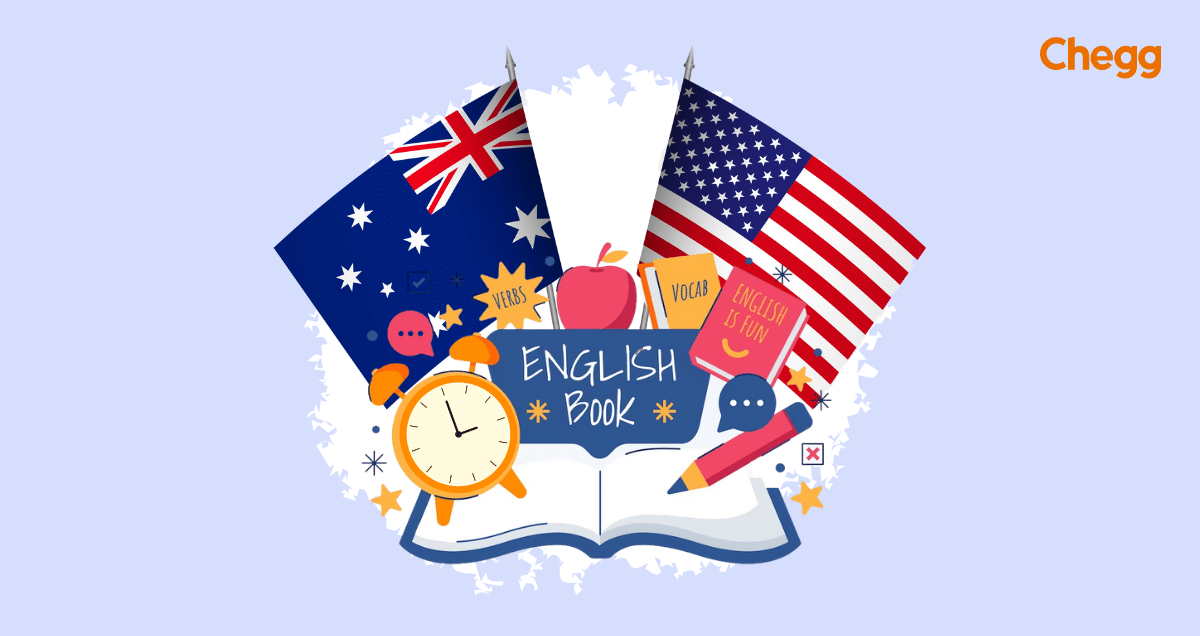

Quick Summary
TOEFL (Test of English as a Foreign Language) and IELTS (International English Language Testing System) are both tests that measure English language proficiency for the purposes of academic study and migration. Though TOEFL and IELTS measure similar skills (e.g., speaking, writing, listening, and reading); they differ in format and scoring. IELTS is most often used for migration to countries such as Canada, Australia and the UK, while TOEFL is most likely what you will require for US universities. The choice of which test to take is sometimes arbitrary and will depend upon your personal choice and the requirements of the institution or organization.
Regarding proving your English proficiency for academic purposes, the TOEFL and IELTS are two of the most widely recognized tests. Choosing between them can be challenging, especially when both exams are accepted globally for university admissions and immigration purposes. So, which is easier TOEFL vs IELTS? To help you make an informed decision, this blog will compare the two tests based on their format, sections, and the skills they assess.
The IELTS (International English Language Testing System) and TOEFL (Test of English as a Foreign Language) are accepted assessments of proficiency in Listening, Reading, Writing, and Speaking English. Hundreds of thousands of institutions worldwide accept IELTS and TOEFL and are required to gain admission to most universities in English-speaking countries.
There are two types of IELTS:
There are two types of TOEFL:
Choosing the proper English language proficiency test can be crucial for many individuals, especially Indian students. Let’s understand the differences between TOEFL and IELTS.
Here is the table that highlights the differences in the format of the IELTS and TOEFL exams. This will help you understand the variations in sections and duration and determine which is more manageable, TOEFL or IELTS.
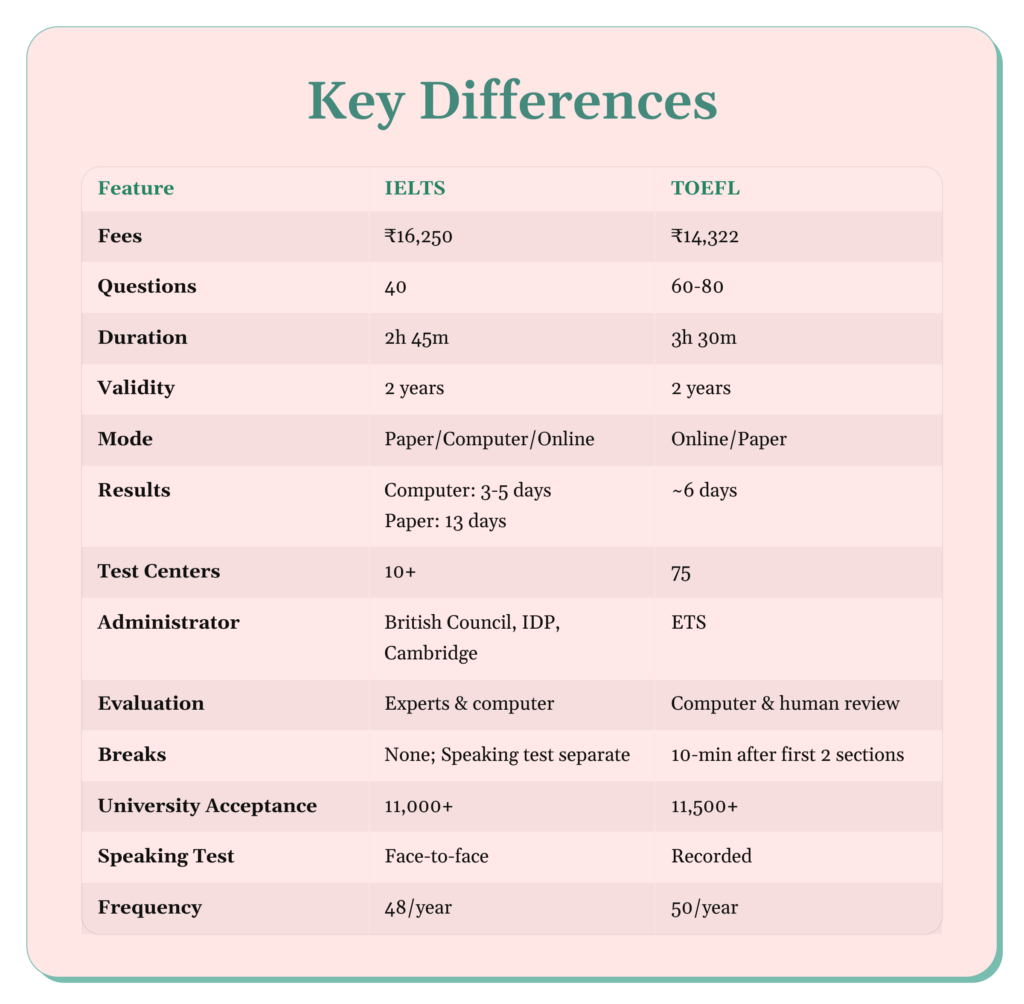

The IELTS exam pattern has four sections: Listening, Reading, Writing, and Speaking. Let’s examine the entire pattern and these four sections.
The TOEFL exam also has four sections. Let us look at the TOEFL exam pattern, questions, and the duration of this exam.

Both exams test English language proficiency but differ in question formats across the sections: Reading, Writing, Listening, and Speaking. Let’s take a closer look at the question types for each section in both TOEFL and IELTS to understand which is easier TOEFL or IELTS.
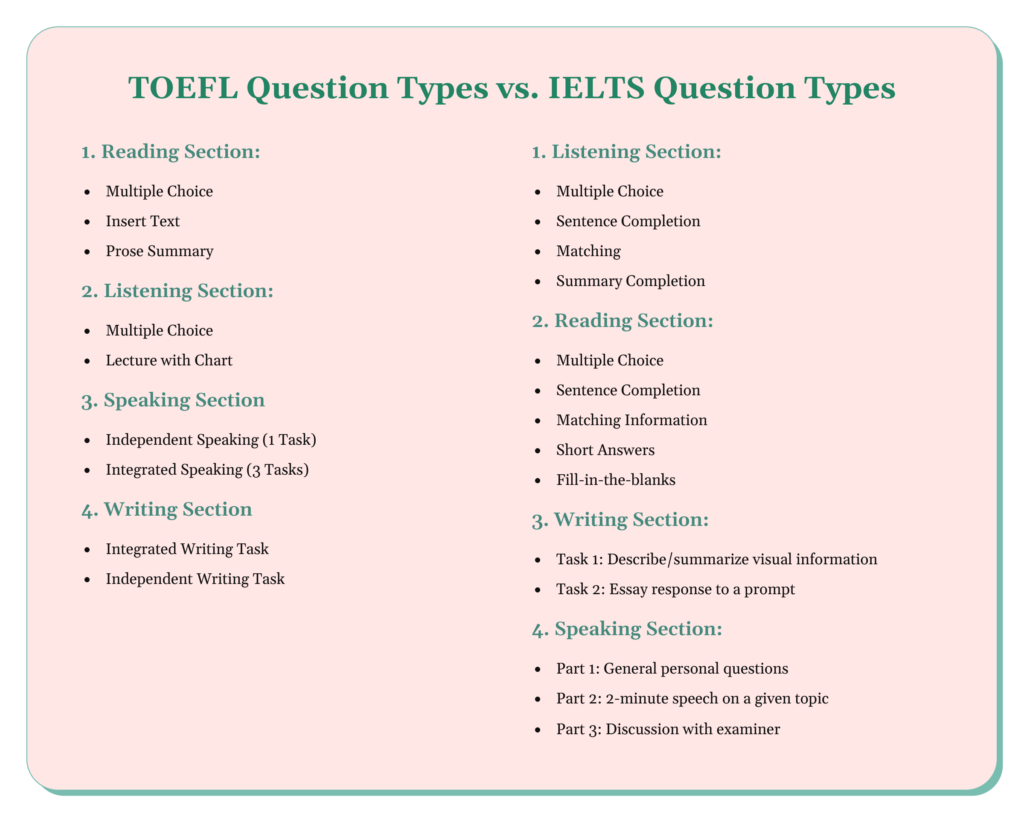
In summary, TOEFL and IELTS have different question types to assess various language skills. TOEFL uses multiple-choice questions mostly, while IELTS has multiple-choice, matching, and sentence completion. So, which is easier, TOEFL or IELTS? Understanding each test’s question format will help you prepare better and make the right choice based on your strengths and preferences.
The listening test checks your understanding of the main ideas and specific details. It recognizes the speaker’s opinions, attitudes, and purpose.
The IELTS Reading test evaluates:
The test includes 3 different passages with related questions. IELTS Academic and IELTS General Training have separate topics. The purpose of the IELTS Reading test is to assess various reading skills.
Tasks include:
The IELTS writing test evaluates different writing skills.
Students face a face-to-face interview with an examiner. It has 3 parts:
Task evaluates candidate’s skills to:
When choosing an English proficiency exam, many students often wonder which is easier TOEFL or IELTS. When choosing the English proficiency exam, many students wonder which is easier, TOEFL or IELTS. Both are widely accepted and recognized globally, including in India. This article compares the two exams and highlights the difficult areas based on popular opinion to help you make the right choice.
The listening sections of both exams test your ability to understand spoken English. However, they have different formats and durations, which leads to the question: Which is easier, TOEFL or IELTS?
In the IELTS Listening section, which is 30 minutes, you will hear 4 conversations, each followed by 10 questions. The recordings are played only once, and you must answer based on your listening skills.
In the TOEFL Listening section, which is 41-57 minutes long, you will hear audio materials like conversations, lectures, and discussions. You will then answer 28-39 questions based on what you hear. Understanding these differences will help you decide which exam is better suited for your listening skills.
In the IELTS Reading section, you will encounter different types of texts and passages, from descriptive to argumentative. You will have to answer questions based on the information given in the texts. So, which is easier, TOEFL or IELTS?
On the other hand, the TOEFL Reading section consists of academic passages that you would typically find in a university environment. The questions test your comprehension of the passages; you must infer and comprehend complex ideas. Understanding these differences will help you decide which exam is better for your reading skills.
The IELTS Writing section requires you to do two tasks:
Task 1, where you summarize, describe, or explain graphic information, and Task 2, where you write an essay on a given topic. So, which is easier, TOEFL or IELTS, when it comes to writing?
TOEFL Writing also has two tasks: an integrated task where you read a passage, listen to a lecture, and then write a response and an independent task where you write an essay on a given topic. Understanding these differences will help you to decide which exam is better for your writing skills.
For IELTS Speaking, you will have a face-to-face conversation with an examiner. The speaking test has three parts:
TOEFL and IELTS exams test your English language skills, but have different formats and approaches. While TOEFL focuses more on academic English, IELTS covers broader contexts. Ultimately, each exam’s difficulty depends on your strengths and weaknesses. You should understand the format and requirements of both exams before deciding which is easier TOEFL or IELTS. Consider factors like test availability, location, fees, and the format that suits you best.
Remember that the scores required by institutions may vary, so when considering which is easier, TOEFL or IELTS, it is essential to check the specific score requirements of your target university or program. This will help you make a more informed decision based on your strengths and the requirements of your desired institution.
It grades you on a nine-band scale to categorize your level of proficiency, from band score 1 (non-user) to band score 9 (expert).
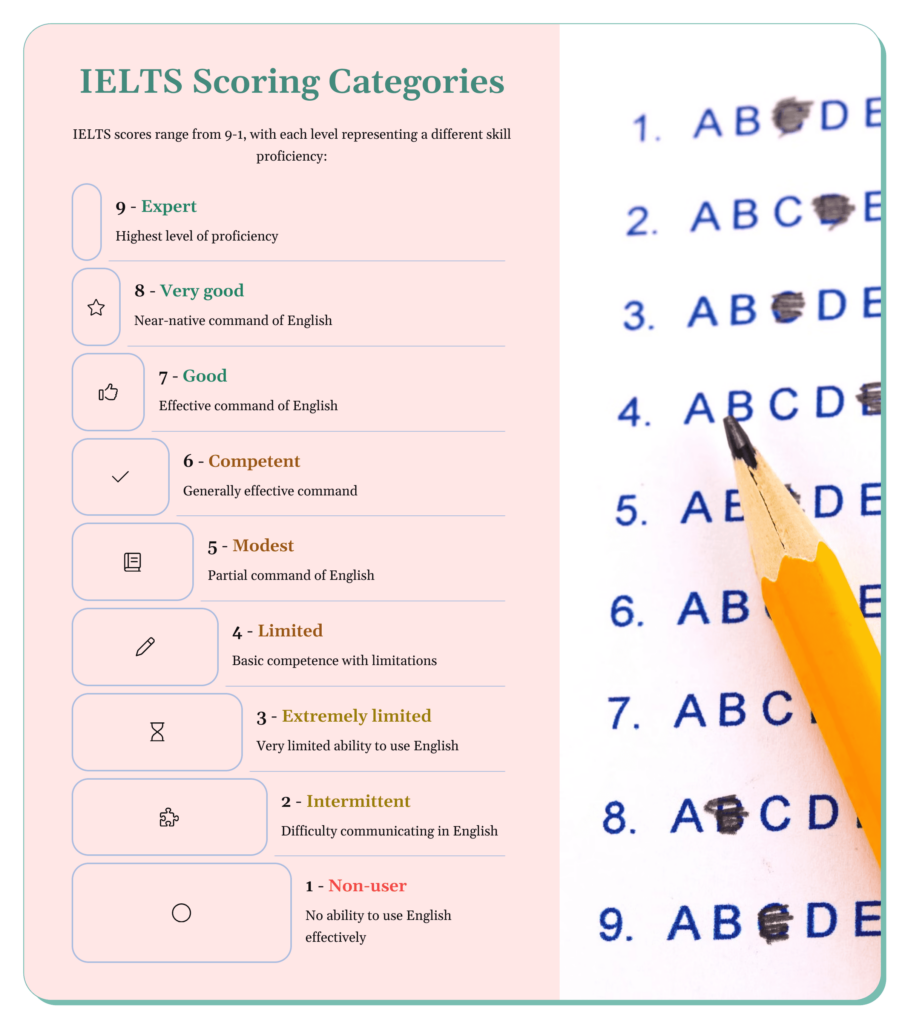
Each test receives a score. These individual scores are averaged and rounded to the nearest half-band to determine the overall band score.
Let’s take an example. The average score for the listening, reading, writing, and speaking sections is 5.75. Then the overall band score will be rounded to 6.0.
In one test, TOEFL evaluates your reading, writing, listening, and speaking skills.
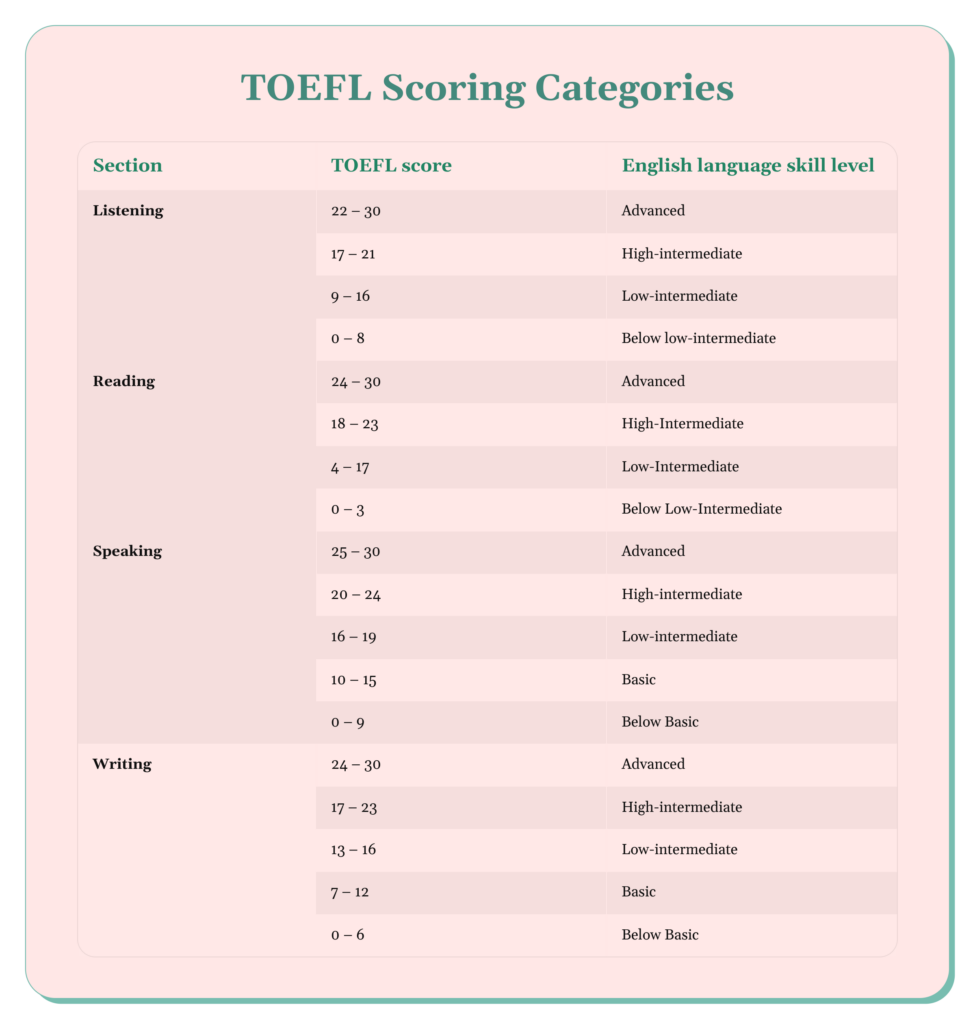
In TOEFL, the total score is calculated by adding these individual scores.
What’s best for you really depends on your goals, personal preferences, and which test format suits you best. Here are a few things to keep in mind while deciding:
Test Duration
Question Types
Typing or Writing
Interaction Style
TOEFL and IELTS are two of the most popular English language proficiency tests accepted by universities, colleges, and immigration authorities worldwide.
Let’s compare TOEFL and IELTS.
Universities in India accept both TOEFL and IELTS. But which is more manageable, TOEFL or IELTS? Your choice may depend on the university. Some universities may prefer one test over the other, so it’s better to check the admission criteria of your desired university or program.
The IELTS difficulty level varies from student to student. As mentioned earlier, the IELTS tests your English language skills in four sections. Each section has its own challenges, but with proper preparation and practice, you can excel in everything.
Taking mock tests, studying vocabulary, and familiarising yourself with the test format can help you overcome difficulties.
TOEFL scores range from 0 to 120. Different universities and programs have different score requirements so it’s better to check the minimum score required for your desired institution.
80 or above is usually considered a good score for institutions. But top universities may require higher scores, usually 90 to 100 or more.
Top universities like Harvard and Stanford have IELTS cut-off scores of 7 or 8. IELTS is scored on a scale of 1 to 9. When comparing which is easier, TOEFL or IELTS, it’s important to note that universities accepting IELTS scores set specific cut-off scores for both overall and individual sections to assess a candidate’s English proficiency. IELTS cut-off scores vary among universities and their programs, so it’s better to check the requirements for your desired institution.
To answer which is more manageable, TOEFL or IELTS, both TOEFL and IELTS have their own challenges. TOEFL is known for its academic approach. It tests American English and focuses on language used in university settings. IELTS, on the other hand, covers both British and American English and has a more general approach. The choice between the two exams depends on your familiarity with the respective accents and preferences.
TOEFL fee: INR 16,900
Both exams are widely accepted and recognized by universities and institutions worldwide.
Familiarize yourself with the test format, practice sample questions, and seek guidance if needed. Remember, it doesn’t matter which is easier, TOEFL or IELTS. Both require consistent effort and dedication to achieve a good score.
Choosing between TOEFL and IELTS depends on your preferences, strengths, and goals. Check the requirements of the institutions you are applying to, the countries you plan to study or work and your comfort level with different English language styles. With proper preparation and a clear understanding of your needs, you can make an informed choice and excel in either exam.
Choosing between IELTS and TOEFL depends on your specific requirements and preferences. Both tests assess your English language skills, but there are some differences. TOEFL might be better if you prefer American English and multiple-choice questions. If you are comfortable with British English and prefer a variety of question formats, IELTS could be the right choice.
The difficulty level of TOEFL varies for individuals. However, many Indian students find TOEFL challenging due to its unique format and emphasis on academic English. It requires strong reading and listening skills and effective time management. With thorough preparation and practice, Indian students can overcome the challenges and succeed in the TOEFL.
The prestige of TOEFL vs IELTS depends on the specific context. TOEFL is accepted by universities in the United States (US) and is commonly accepted in countries like the United Kingdom, Australia, and Canada.
The difficulty level in IELTS can vary for Indian students based on their proficiency in English and familiarity with the test format. However, IELTS tests your English language skills fully. Indian students who have a good command of English and dedicate sufficient time to prepare for the test can achieve favorable results in the IELTS.
It depends on your strengths and preferences. TOEFL is often favored by those comfortable with American English and a computer-based test format, while IELTS may suit those who prefer British English and a paper-based approach.
Yes, the IELTS (International English Language Testing System) is widely accepted in the USA for both academic and immigration purposes
The IELTS exam validity is set to two years to ensure your English language skills remain current and relevant
You may take the IELTS test as many times as you like. You can use the result of the test you prefer.

Authored by, Gagandeep Khokhar
Career Guidance Expert
Gagandeep is a content writer and strategist focused on creating high-performing, SEO-driven content that bridges the gap between learners and institutions. He crafts compelling narratives across blogs, landing pages, and email campaigns to drive engagement and build trust.
Editor's Recommendations
Chegg India does not ask for money to offer any opportunity with the company. We request you to be vigilant before sharing your personal and financial information with any third party. Beware of fraudulent activities claiming affiliation with our company and promising monetary rewards or benefits. Chegg India shall not be responsible for any losses resulting from such activities.
Chegg India does not ask for money to offer any opportunity with the company. We request you to be vigilant before sharing your personal and financial information with any third party. Beware of fraudulent activities claiming affiliation with our company and promising monetary rewards or benefits. Chegg India shall not be responsible for any losses resulting from such activities.